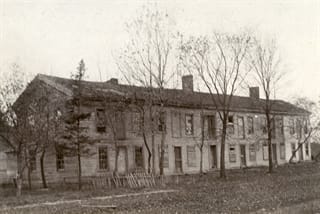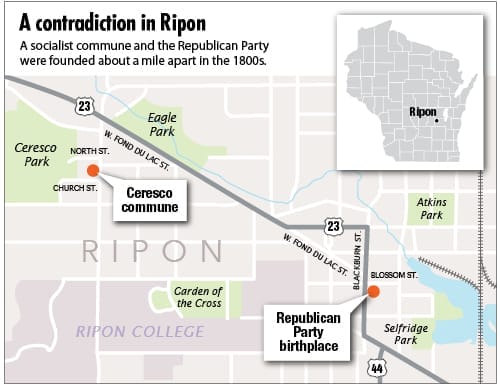1800s utopian commune called Ceresco was established — and collapsed — just blocks from where GOP was later founded
Bernie Sanders is out of the presidential race, but support for the Vermont senator and his socialist ideology runs deep in the Democratic Party, particularly among young voters who don’t know the long history of failed socialist experiments across the globe.
And right here in Wisconsin.
Most Wisconsinites likely know that in 1854, the Badger State birthed the Republican Party in Ripon’s Little White Schoolhouse. The party was originally a mix of Whigs, Free Soilers and the Liberty Party, glued together by their opposition to slavery and a belief in the principles of individual liberty, life and property.

Thus, it may be surprising for many to learn that one of the most famous socialist experiments began — and failed — in the same town where the Grand Old Party was founded.
There, a decade earlier, Warren Chase established a utopian commune known as the Wisconsin Phalanx. It was based on the ideology of Charles Fourier, a wealthy French philosopher whose fortune was created by his free-market businessman father.
An extreme anti-Semite, anti-Christian and anti-free marketer, Fourier envisioned a society dotted with communes he called phalanxes. People lived in a phalanstery, a large multi-story building where they would work, play and meet.
Fourier was a proponent of sexual freedom and free love. He thought that by creating a holistic lifestyle, where people could change jobs and partners at will, cooperation would rule and everyone would reap the communal benefits.
Property and economic activity were owned by the community, and shares in the phalanstery, in place of cash, were used to distribute goods to members of the commune. Members were compensated based on their contribution. Children could begin work at age 2, and families were discouraged from having too many of them.
The Ceresco commune
To establish the Wisconsin Phalanx in 1844, Chase, of Southport (today’s Kenosha), acquired 600 acres in what is now Ripon and later acquired another 1,000 acres.
Incorporated in 1845 under his presidency, the village was named Ceresco after the Roman god of the harvest, Ceres. Wheat agriculture was the primary activity, and membership in the commune was based on investment, similar to a modern cooperative.
Members constructed a collective dwelling called a long house; it was designed to hold 20 to 30 families and included a common dining hall. A school for children was established in Ceresco, against the Fourier philosophy.
Alcohol was prohibited, while gambling and profanity were discouraged. The lifestyle was primarily collectivist, membership was controlled by a board of managers and people could be expelled.
People were divided into three hierarchical classes. The first was “necessity,” whose members performed hard labor and received the largest share of resources. Next was “usefulness,” whose members engaged in trade, agriculture and teaching. Last was “attractiveness,” or domestic work, which, against Fourier’s thinking, was almost exclusively women.
So, why did Ceresco fail?
The rigid hierarchy was repressive and lacked social mobility. Also, the collective nature of the lifestyle alienated individual nuclear families, who desired some degree of privacy.
At its peak in 1846, the commune had about three dozen families and 200 total residents. By 1848 (when Chase served a term in the state Senate), only 29 families remained.
The commune’s limited revenue could not pay everyone for their work, which led many to seek jobs elsewhere. In addition, women were disenchanted by the failed promises of equality.
Charlotte Mason, in an 1848 letter to her sister, described some residents as lazy and disgruntled. Strife arose between the irreligious and the multiple religious denominations.
But the greatest issues were the lack of economic advancement and the monotony imposed by the economic system.
By 1850, the socialist experiment was over. It took an act of the Wisconsin Legislature to allow the sale of the commune’s property to individuals, and in 1853 the villages of Ceresco and Ripon were merged and renamed Morena. That name didn’t stick, and the City of Ripon was established in 1858.
In the end, Ceresco — as did its counterparts in Brook Farm, Massachusetts, and New Harmony, Indiana — failed because the human spirit does not desire to be crushed into hierarchies, enforced systems, infantilized equality and bizarre ideologies.
Left-wing ideologies are fundamentally sad and unhappy with humanity and wish to engineer mankind to fit some archetypal mold.
History has shown that the human spirit will always rebel against this and that the only way for any type of socialism to succeed is through violence, coercion and intimidation.
Dr. Lamont Colucci is a professor of politics and government at Ripon College. He is coordinator of the college’s National Security Studies program.







